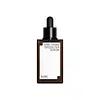What's inside
What's inside
 Key Ingredients
Key Ingredients

 Benefits
Benefits

 Concerns
Concerns

No concerns
 Ingredients Side-by-side
Ingredients Side-by-side

Water
Skin ConditioningDiglycerin
HumectantPolyglycerin-3
HumectantButylene Glycol
HumectantGlycerin
Humectant1,2-Hexanediol
Skin ConditioningSaccharomyces/Rice Ferment Filtrate
Skin ConditioningCamellia Sinensis Leaf
PerfumingTrehalose
HumectantAcrylates/C10-30 Alkyl Acrylate Crosspolymer
Emulsion StabilisingSodium Hyaluronate
HumectantPropanediol
SolventPolyglyceryl-10 Laurate
Skin ConditioningAllantoin
Skin ConditioningSodium Citrate
BufferingEthylhexylglycerin
Skin ConditioningAdenosine
Skin ConditioningCitric Acid
BufferingXanthan Gum
EmulsifyingGlyceryl Acrylate/Acrylic Acid Copolymer
HumectantDisodium EDTA
Pvm/Ma Copolymer
Emulsion StabilisingHydroxypropyltrimonium Hyaluronate
Sodium Acetylated Hyaluronate
HumectantHydrolyzed Hyaluronic Acid
HumectantHyaluronic Acid
HumectantSodium Hyaluronate Crosspolymer
HumectantHydrolyzed Sodium Hyaluronate
Skin ConditioningPotassium Hyaluronate
Skin ConditioningWater, Diglycerin, Polyglycerin-3, Butylene Glycol, Glycerin, 1,2-Hexanediol, Saccharomyces/Rice Ferment Filtrate, Camellia Sinensis Leaf, Trehalose, Acrylates/C10-30 Alkyl Acrylate Crosspolymer, Sodium Hyaluronate, Propanediol, Polyglyceryl-10 Laurate, Allantoin, Sodium Citrate, Ethylhexylglycerin, Adenosine, Citric Acid, Xanthan Gum, Glyceryl Acrylate/Acrylic Acid Copolymer, Disodium EDTA, Pvm/Ma Copolymer, Hydroxypropyltrimonium Hyaluronate, Sodium Acetylated Hyaluronate, Hydrolyzed Hyaluronic Acid, Hyaluronic Acid, Sodium Hyaluronate Crosspolymer, Hydrolyzed Sodium Hyaluronate, Potassium Hyaluronate
Camellia Sinensis Leaf Extract
AntimicrobialWater
Skin ConditioningButylene Glycol
HumectantGlycerin
HumectantPropanediol
SolventDipropylene Glycol
HumectantNiacinamide
Smoothing1,2-Hexanediol
Skin ConditioningPanthenol
Skin ConditioningHydroxyacetophenone
AntioxidantSqualane
EmollientAmmonium Acryloyldimethyltaurate/Vp Copolymer
Allantoin
Skin ConditioningCarbomer
Emulsion StabilisingTromethamine
BufferingBetaine
HumectantPolyglyceryl-3 Methylglucose Distearate
EmulsifyingCetearyl Alcohol
EmollientEpigallocatechin Gallate
AntioxidantGlyceryl Stearate Se
EmulsifyingAdenosine
Skin ConditioningDipotassium Glycyrrhizate
HumectantBacillus Ferment
Skin ConditioningVigna Radiata Seed Extract
Skin ConditioningCamellia Japonica Flower Extract
EmollientPinus Palustris Leaf Extract
TonicUlmus Davidiana Root Extract
Skin ConditioningOenothera Biennis Flower Extract
AstringentPueraria Lobata Root Extract
HumectantBrassica Oleracea Italica Sprout Extract
EmollientCamellia Sinensis Leaf Extract, Water, Butylene Glycol, Glycerin, Propanediol, Dipropylene Glycol, Niacinamide, 1,2-Hexanediol, Panthenol, Hydroxyacetophenone, Squalane, Ammonium Acryloyldimethyltaurate/Vp Copolymer, Allantoin, Carbomer, Tromethamine, Betaine, Polyglyceryl-3 Methylglucose Distearate, Cetearyl Alcohol, Epigallocatechin Gallate, Glyceryl Stearate Se, Adenosine, Dipotassium Glycyrrhizate, Bacillus Ferment, Vigna Radiata Seed Extract, Camellia Japonica Flower Extract, Pinus Palustris Leaf Extract, Ulmus Davidiana Root Extract, Oenothera Biennis Flower Extract, Pueraria Lobata Root Extract, Brassica Oleracea Italica Sprout Extract
 Reviews
Reviews

Ingredients Explained
These ingredients are found in both products.
Ingredients higher up in an ingredient list are typically present in a larger amount.
1,2-Hexanediol is a synthetic liquid and another multi-functional powerhouse.
It is a:
- Humectant, drawing moisture into the skin
- Emollient, helping to soften skin
- Solvent, dispersing and stabilizing formulas
- Preservative booster, enhancing the antimicrobial activity of other preservatives
Adenosine is in every living organism. It is one of four components in nucleic acids that helps store our DNA.
Adenosine has many benefits when used. These benefits include hydrating the skin, smoothing skin, and reducing wrinkles. Once applied, adenosine increases collagen production. It also helps with improving firmness and tissue repair.
Studies have found adenosine may also help with wound healing.
In skincare products, Adenosine is usually derived from yeast.
Learn more about AdenosineAllantoin is a soothing ingredient known for its protective and moisturizingg properties. Because of this, it is often added to products with strong active ingredients.
Studies show higher concentrations of this ingredient can promote wound healing.
Though it can be derived from the comfrey plant, allantoin is produced synthetically for cosmetic products to ensure purity.
Learn more about AllantoinButylene Glycol (or BG) is used within cosmetic products for a few different reasons:
Overall, Butylene Glycol is a safe and well-rounded ingredient that works well with other ingredients.
Though this ingredient works well with most skin types, some people with sensitive skin may experience a reaction such as allergic rashes, closed comedones, or itchiness.
Learn more about Butylene GlycolGlycerin is already naturally found in your skin. It helps moisturize and protect your skin.
A study from 2016 found glycerin to be more effective as a humectant than AHAs and hyaluronic acid.
As a humectant, it helps the skin stay hydrated by pulling moisture to your skin. The low molecular weight of glycerin allows it to pull moisture into the deeper layers of your skin.
Hydrated skin improves your skin barrier; Your skin barrier helps protect against irritants and bacteria.
Glycerin has also been found to have antimicrobial and antiviral properties. Due to these properties, glycerin is often used in wound and burn treatments.
In cosmetics, glycerin is usually derived from plants such as soybean or palm. However, it can also be sourced from animals, such as tallow or animal fat.
This ingredient is organic, colorless, odorless, and non-toxic.
Glycerin is the name for this ingredient in American English. British English uses Glycerol/Glycerine.
Learn more about GlycerinPropanediol is an all-star ingredient. It softens, hydrates, and smooths the skin.
It’s often used to:
Propanediol is not likely to cause sensitivity and considered safe to use. It is derived from corn or petroleum with a clear color and no scent.
Learn more about PropanediolWater. It's the most common cosmetic ingredient of all. You'll usually see it at the top of ingredient lists, meaning that it makes up the largest part of the product.
So why is it so popular? Water most often acts as a solvent - this means that it helps dissolve other ingredients into the formulation.
You'll also recognize water as that liquid we all need to stay alive. If you see this, drink a glass of water. Stay hydrated!
Learn more about Water